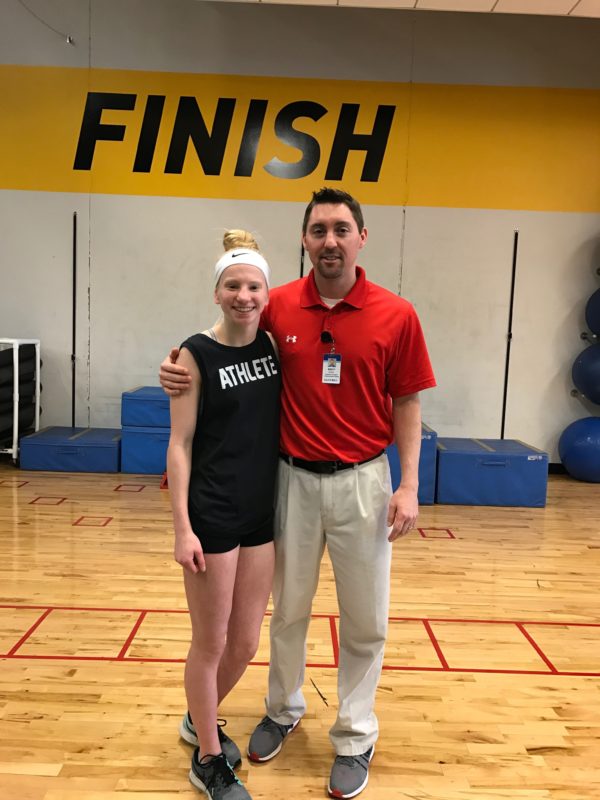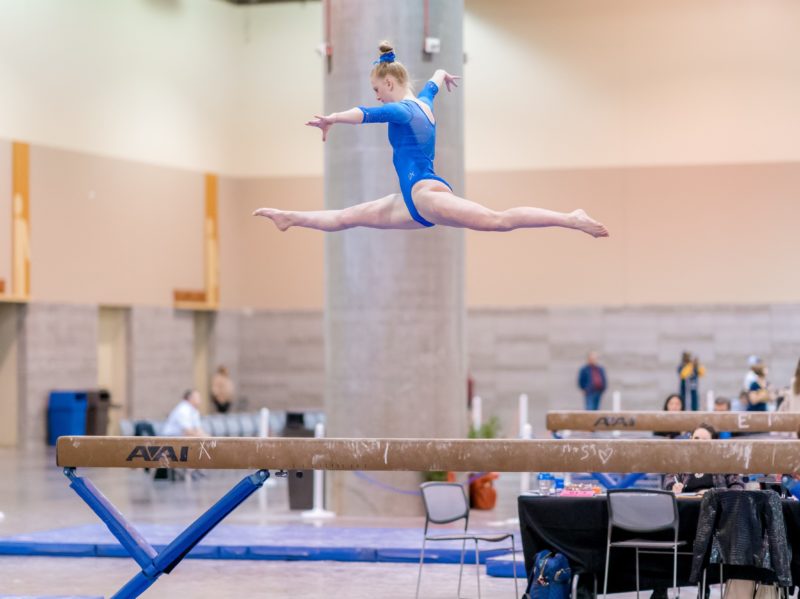Keira Boetel learned to deal with the occasional unintended tumble to the floor. She always bounced up and got back to work.
Heading into her freshman year of high school, that was how this gymnast rolled. And flipped. If it didn’t work quite right, well, get up and try again.
But in the moments after attempting an elite balance-beam maneuver that would take two paragraphs to accurately describe, she landed awkwardly, fell to the ground and stayed there. Something was wrong.
This story has a happy ending. Boetel worked her way back to competition after nine months, progressing through a difficult rehab process that left such a positive impression on her that she now serves as a volunteer, shadowing the work of Sanford Health physical therapists.
But starting with the day she made an unsuccessful attempt at practice to do a handspring that included two layouts and two step-outs — and for the months that followed — the grind was real.
Traumatic week
“I heard a pop, which freaked me out a lot,” said Boetel, who is going into her senior year of high school at O’Gorman. “I knew something was wrong. I just didn’t know how significant it was going to be.”
She pondered what might come next. None of these scenarios sounded so great, but maybe she wasn’t as severely injured as she thought.
“I was very nervous when it happened,” she said. “’Oh my gosh, what happened? What is going on?’ I was scared out of my mind because I didn’t know what to expect. Plus, I was in a lot of pain.”
The self-denial lasted most of a week. Suspecting the injury was worse than their daughter was letting on, parents Kerry and Tom Boetel, a non-surgical back and neck care specialist, took Keira in to see Dr. Bradley Reeves, who strongly suggested she would need surgery. And even then, Keira held out hope the MRI results would provide better news.
“I told Keira, ‘You have to prepare yourself for when the results come back,’” Kerry said. “Then we had to go back in and she had to hear it: ‘Yes, you tore just about everything you can tear in your knee. This is bad. You’re going to be out the next seven to nine months.’”
Keira went home, crawled into bed and sobbed.
Meeting challenges
Looking back, the Boetels now call it “The year of silver linings.”
“Yes she was crushed, it was really hard, but she learned a lot more about herself in those 10 months,” Kerry said. “She realized ‘I can come back. I can get through this.’”
Keira’s first visit to physical therapy was the day after surgery. On crutches and dealing with both physical and emotional wounds, she met with Brett Fischer, a Sanford Health physical therapist who specializes in helping athletes rehab after surgery.
“Right away he put her at ease,” Kerry remembers. “It was, ‘We will get through this. You will get through this. We will get through this together.’”
Fischer knew better than Keira did about what it was going to take. Getting back to “normal” was one thing. Getting back to where she wanted to be was another.
“It’s always difficult when you have athletes like that who want to get back to really, really high-level things,” Fischer said. “It’s typically a little easier when kids just want to get back to being kids. When you want to get back to being that level of an athlete like Keira did, it just takes that much more work.”
Boetel and Fischer

Photo courtesy of Kerry Boetel
She and Fischer formed a team. The physical therapist brought the motivation and knowledge. Keira supplied the personal resolve. She would devote the same passion to her recovery that she had to her gymnastics.
“I was devastated but whatever happens, happens,” Keira said. “I turned my whole summer around to aim my motivation at making my knee better and stronger. The healing process I started right away, even though I couldn’t get surgery until three weeks after it happened.”
By any measure, this was a serious injury, but particularly so for a competitive gymnast. Athletes must constantly hone the maneuvers they use in competition in this sport while also increasing the complexity of their routines in practice.
In both cases, confidence is a necessity.
“I wanted to be fully recovered so that I could get back into the sport I loved,” Boetel said. “My goal is to be a college gymnast. I still had four years left when it happened. I was going to try my best to get fully recovered so that I didn’t have to worry about my knee. That was the goal because I wanted to have confidence in myself. I didn’t want any stress over my knee.”
Less than a year after the injury, Boetel capped her comeback by winning the Level 9 Senior All-Around medal at the South Dakota State Championships. She then added a USA Gymnastics Regional All-Around title the same season.
Fischer did his part by slicing the long recovery into digestible portions. This challenge wasn’t going to be about being ready to go a year from now, it was going to be about being a little better next week. And then the week after that.
“When people are that competitive and want to get back to that high a level it’s pretty easy for me to give them an attainable goal,” Fischer said. “They’re naturally competitive and will work toward that. That was the biggest thing for Keira – keep her focused on what the next thing is going to be.”
Better for the experience
The gymnast who recovered from an ACL and meniscus tear is mentally tougher now, her mother said, and more aware of the challenges that come with competing in gymnastics.
“You see it now with the empathy she has when one of the other gymnasts gets hurt,” Kerry said. “She’s the first one to their side, the first one to give them a card. So many parents of younger gymnasts have told us what she’s done for their child.”
While Keira pursues her goal of becoming a college gymnast, the process that put her in position to keep that dream alive also motivated her to re-visit the rehab environment, this time from the other side.
“Ever since the injury I’ve been interested in physical therapy,” she said. “I’ve done some shadowing with Brett and some at the hospital. I feel like I got inspired and helped by one physical therapist and now I think my path in life is to go help other people get back to their sport or whatever it is that they love to do in life.”
Back to her sport, and more
She spends her Tuesday afternoons with Fischer and others from the staff at Sanford Sports Medicine and Rehabilitation area at the Sanford Fieldhouse. Her work as a volunteer has given her a view of the job she didn’t see while recovering from surgery. She has been witness to a lot of paperwork, for one thing, but it is all in a patient’s best interest.
“They really focus on every patient — what they want to accomplish and their goals,” Keira said. “The relationships I’ve enjoyed and the way I’ve been able to pass that along to other people has affected me in such a good way. I think it has helped me in life and in gymnastics.”
Given her age, there may yet be career changes. The fact that she got through the ordeal, however, and felt good enough about the experience to consider it as a possible career choice means Fischer was doing his job pretty well.
“The most rewarding thing is the fact that she had as good of an experience as she did,” Fischer said. “It was good enough that maybe she wants to do that the rest of her life. It’s one thing to get them back to their sport, because that doesn’t always happen. That’s a big win. It’s the next level when they decide that they want to look into it as a career. Then you know they had a good experience and you were able to have an impact on them, too.”
Learn more
- Athletic trainer helps keep ankle injury from ending season
- Pediatric physical therapy in the classroom
- ACL injury is focus of Fargo researchers
…
Posted In Rehabilitation & Therapy, Sanford Sports, Sports Medicine
